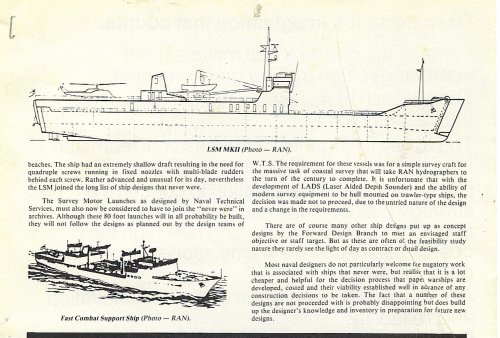Paving the Way, Volume IV: The Royal Australian Engineers 1945 to 1972
Chapter 11 Movements and Transport pp 396-397
In the years after the war, particular with Australia’s commitment to PNG and later to SEATO, the Army maintained its interest in small craft. The need to move Centurion tanks dictated the Military Board decision to purchase the first two Landing Ships, Medium (LSM). The purchase of the second two LSMs was initiated by the Chairman of the Joint Planning Committee, Cdre. Alan McNicoll, who urged that Defence should sponsor the acquisition. The Defence Committee decided that Army would sponsor the acquisition of the additional LSMs.
While the LSM gave great flexibility in the deployment and support of an Australian force, there was a diminishing number of Australian owned ships suitable for military cargo and, in 1963, DTn [Director of Transport, Lt.Col. Phil Greville] put forward a proposal for Army to acquire a suitable ship for that purpose. He proposed that the ship be loaned back to the Australian National Line for use on certain prescribed tasks then not needed by Army. The Chief of Naval Staff (CNS) proposed that it be manned by RAN. Greville opposed this in a Minute to DMO&P claiming that while ever it is considered a ‘white ensign ship, trouble will be experienced getting any naval officer to understand the purpose for which the ship is wanted.
He claimed that the CNS in his letter had illustrated this when claiming that the type of ship suggested, a Mariner Class ship with between 50 and 60 officers and men could not operate in any way other than as a cargo ship. Greville agreed. He also agreed that if any amphibious capability was approved, and an assault cargo vessel (AKA) was acquired, then the CNS was correct in stating that such a ship would required 38 officers and 400 men to crew it. This claimed Greville:
“…highlights the difference in philosophy between Navy and Army. Army uses all sorts of simple cargo vessels and produces the terminal organisation to work the winches, the hatches, the stowage, etc. as well as planning the loading and discharge, operating the lighterage and shore (including beach) facilities [at the port]. It is most uneconomical to provide on board every ship this type of (terminal) organisation.”
Greville eventually proposed that a more modern ship than the Mariner be purchases, such as a Scandia at $5m. It needed far less crew and the gear was more modern. The Defence Committee sponsored a study, which found the Scandia was too big and recommended the purchase of two ships about half the size. Procrastination over the procurement of a logistic ship meant that it as never available for Vietnam. In that time it cost Army over $10m to hire MV Jeparit and some millions more to hire Bonnooroo and Harima Maru. If a ship and been brought in 1964, its cost would have been saved in the Vietnam years alone. Navy eventually got its way and built in Australia, a British Landing Ship Logistics (LSL), which it named HMAS Tobruk. This ship never met the requirements that Navy insisted upon through its resistance to the Army procuring a ship. HMAS Tobruk cost over $50m.
Recognising that the excellent LSM had a limited life, DTn set in train the long process of obtaining a replacement vessel, which he called the LSM Mk 2. He set out, with the help of Maj. J.S. Wilson to draw up a set of characteristics that included the best of the LSM and the experience of six years’ operation of the four vessels. The RAN had no experience in landing ships, nor had the Australian Ship Building Board, and he sought permission to advertise for a design contract. This was won by Dr Corlette, consultant to the British Indian Shipping Company, who was not only a naval architect but an aeronautical engineering. This was an advantage as the LSM hull exhibited many characteristics of aeroplane design. After experiencing the capabilities of the LSM, Dr Corlette declared that ‘the ship must have been the last designed by three competent professionals. Naval architect, marine engineer and electrical engineer, modern ships being too often the result of the machinations of committees’.
The LSM Mk 2 got to the stage of being model tested and costed at $2.5m, but Navy opposed the LSM Mk II on the grounds that they were larger and faster than the original ships and therefore not within the Army’s responsibilities. A decision was made then to replace the proposed LSM Mk II by eight Landing Craft Utility, to be built in Australia and renamed Landing Craft Heavy (LCH). DTn (now Lt. Col. Hallet) accepted reluctantly the decision knowing that these craft had a much lesser capability for self-deployment than the LSM and the eight LCH would carry less than four LSM. DTn intended to man the craft with eleven soldiers, with a Warrant Officer in charge of each craft.



